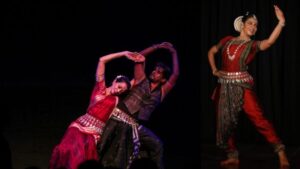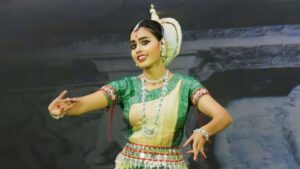Odissi, one of the classical dance forms of India, is a mesmerizing tapestry of grace, storytelling, and spirituality. Its journey from the sacred temples of Odisha to the grand stages of the world is a testament to the resilience and evolution of an ancient art form. In this 2000-word article, we will trace the historical trajectory of Odissi dance, from its origins in temple rituals to its current status as a celebrated stage performance art.
Origins in Temple Rituals
The roots of Odissi dance can be traced back over two thousand years to the temples of Odisha, a coastal state in eastern India. It was born in the precincts of the sacred Jagannath Temple in Puri and the Lingaraj Temple in Bhubaneswar. These temples served as the cradle for Odissi’s development and evolution.
Devadasis: The Temple Dancers
At its inception, Odissi was a form of worship rather than entertainment. It was primarily performed by devadasis, young girls who were dedicated to serving the temple deities through music and dance. These devadasis were not only dancers but also repositories of temple rituals, history, and cultural traditions.
The Role of Odissi in Temple Rituals
Odissi played a vital role in temple rituals and festivals. Devadasis would perform dances as offerings to the deities. These dances, known as “Mahari” and “Devadasi” dances, were an integral part of temple ceremonies and were believed to invoke blessings and divine favor.
The Influence of the Natya Shastra
The Natya Shastra, an ancient treatise on Indian performing arts, provided a theoretical framework for dance, including Odissi. It prescribed the use of mudras (hand gestures), abhinaya (expressions), and intricate footwork to convey stories and emotions. Odissi drew upon the principles outlined in this ancient text to develop its distinctive style.
Challenges and Decline
Despite its rich history and cultural significance, Odissi faced several challenges over the centuries, leading to a decline in its practice.
Colonial Suppression
During the colonial era, British rulers and Christian missionaries sought to suppress traditional Indian art forms, including temple dances like Odissi. Many devadasis were stigmatized and marginalized, and temple dances were discouraged or banned.
Cultural Shifts
As India underwent social and cultural transformations in the 19th and 20th centuries, the practice of devadasi traditions dwindled. The decline of devadasi culture resulted in the loss of many talented dancers and their knowledge.
Revival Efforts
Despite these challenges, Odissi was not forgotten. A revival of the art form began in the early 20th century, driven by individuals and institutions dedicated to preserving and rejuvenating India’s classical heritage.
Pioneers of the Odissi Revival
The revival of Odissi owes much to the pioneering efforts of several individuals who sought to revive and promote the art form.
Guru Pankaj Charan Das
Guru Pankaj Charan Das, often referred to as the “Father of Odissi,” played a pivotal role in resurrecting Odissi dance. He dedicated his life to teaching and preserving the art form, passing on his knowledge to future generations.
Kelucharan Mohapatra
Another luminary in the Odissi revival was Guru Kelucharan Mohapatra. His choreography and innovative approach to Odissi earned him recognition and accolades, making Odissi more accessible to a global audience.
Sanjukta Panigrahi
Sanjukta Panigrahi, a legendary Odissi dancer, contributed significantly to popularizing the dance form in India and abroad. Her performances showcased the beauty and storytelling prowess of Odissi.
Transformation into a Stage Performance Art
The revivalists and pioneers of Odissi played a crucial role in transforming it from a temple ritual to a stage performance art. This transformation involved several key elements:
Choreography and Repertoire
Under the guidance of gurus like Kelucharan Mohapatra, Odissi developed a structured repertoire of items suitable for the stage. These items included traditional compositions as well as innovative choreography.
Costumes and Makeup
Odissi underwent a makeover in terms of costumes and makeup. Dancers now wore elaborate costumes, adorned with jewelry and makeup that accentuated their expressions and movements. The costumes, often inspired by temple sculptures, added to the visual appeal of Odissi on stage.
Music and Instruments
The music accompanying Odissi performances evolved to incorporate various classical and traditional musical forms of Odisha. Instruments like the mardala (a percussion instrument) and flute became integral to Odissi music.
Incorporation of Abhinaya
While Odissi was originally rooted in temple rituals, it evolved to incorporate abhinaya, the expressive aspect of dance. Dancers began to emphasize conveying emotions and stories, making it more accessible and engaging for a wider audience.
Odissi on the Global Stage
The efforts to revive and promote Odissi did not go unnoticed, and the dance form gradually gained recognition on the international stage.
International Tours and Collaborations
Talented Odissi dancers and choreographers embarked on international tours, showcasing the beauty and intricacy of the dance form. Collaborations with artists from around the world further expanded Odissi’s reach.
Recognition and Awards
Odissi received recognition and accolades at both the national and international levels. Dancers like Sanjukta Panigrahi and Sonal Mansingh were honored for their contributions to Indian classical dance.
Contemporary Odissi
Today, Odissi continues to thrive as a dynamic and evolving dance form. It has embraced contemporary themes while preserving its traditional essence.
Innovation and Experimentation
Contemporary Odissi choreographers and dancers are not bound by rigid traditions. They are exploring new themes, music, and choreographic styles while staying true to the core principles of the dance.
Educational Institutions
Several educational institutions in India and abroad offer formal training in Odissi. This has further contributed to the spread and preservation of the art form.
Cultural Festivals
Odissi is a regular feature at cultural festivals and events, both in India and internationally. These platforms provide exposure and recognition to budding Odissi artists.
Conclusion: Odissi’s Enduring Legacy
The journey of Odissi from the temple sanctums of Odisha to the global stage is a testament to its enduring legacy and resilience. Despite facing challenges, including colonial suppression and social shifts, Odissi has not only survived but thrived. Thanks to the dedication of its revivalists, pioneers, and contemporary practitioners, Odissi has evolved into a vibrant and cherished classical dance form that continues to captivate audiences worldwide.
Today, Odissi stands as a bridge between the past and the present, connecting us to the rich cultural heritage of India while embracing the creativity and innovation of the modern world. It reminds us that art, like the human spirit, has the power to transcend time and boundaries, leaving an indelible mark on the hearts and minds of those who are fortunate
enough to witness its beauty and grace on the stage.




